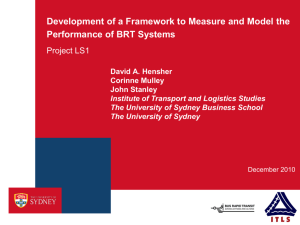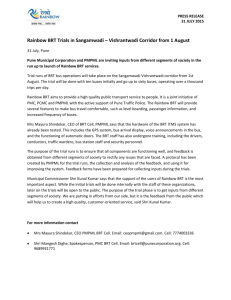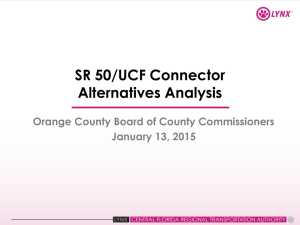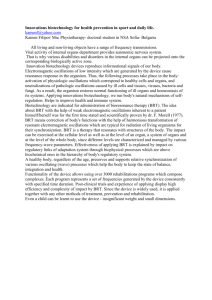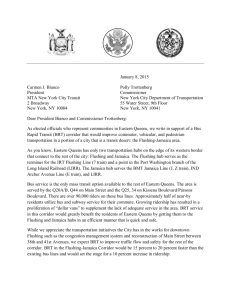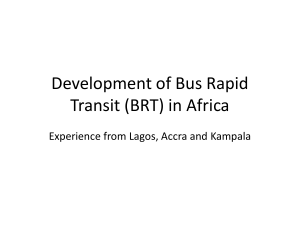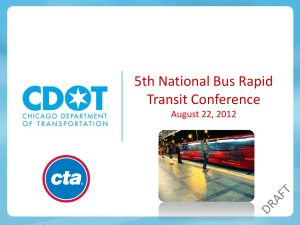UNIS Template - Across Latitudes and Cultures
advertisement
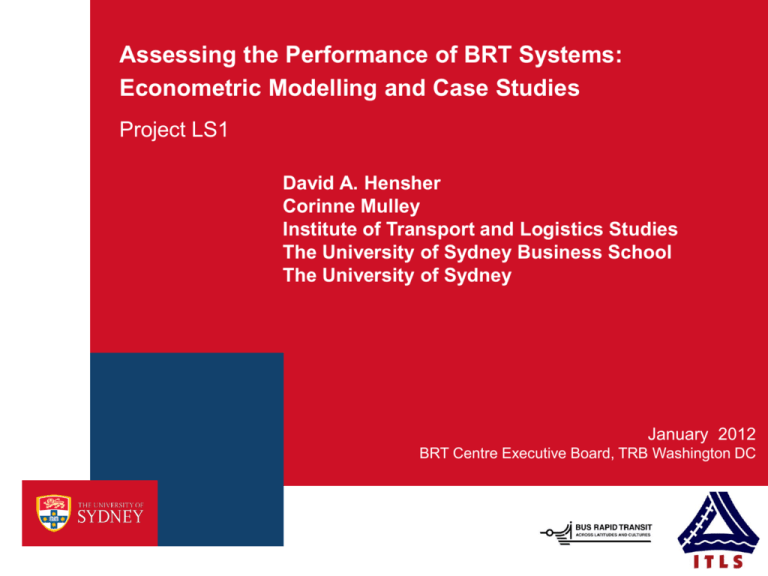
Assessing the Performance of BRT Systems: Econometric Modelling and Case Studies Project LS1 David A. Hensher Corinne Mulley Institute of Transport and Logistics Studies The University of Sydney Business School The University of Sydney January 2012 BRT Centre Executive Board, TRB Washington DC Current status of LS1 objectives (2010-2012) Obj 1: Review and evaluate methodological approaches within which to quantify the salient factors that define the dimensions of performance of BRT systems Completed Obj 2: Identify and review existing data sources to identify gaps in data needs, and a data collection strategy to obtain all necessary data Completed Obj 3: to set out the selected method in sufficient detail so as to ensure that it is capable of estimation so as to deliver an agreed set of performance metrics Completed Obj 4: to undertake model estimation of data from secondary sources, including compilation of very detailed data for selected systems as the basis of case studies Ongoing but subject to Data Concerns Obj 5: to use the evidence to define criteria for selecting BRT systems that should be included by invitation as members of a ‘BRT cities club’. Not Commenced Reminder: Key Elements completed in the 2010 Work Program › Identifed the influencing dimensions within a framework broadly distinguising internal and external factors. - The external factors emphasised the institutional, cultural, geographic influences including evidence on modal biases present in the population as a whole and key stakeholders. › Identified key externalities (noise, congestion, safety, emissions) and how they should be sourced and measured and built into the performance assessment framework. Key Elements completed in the 2011 Work Program › Commencement of Detailed Case Studies of three Australian Busway Systems (Liverpool-Parramatta and Rouse Hill to Parramatta/Blacktown Transitways in Sydney and the Brisbane Busway System). › Working closely with Embarq and PUC to resolve concerns about adequacy (inadequacy) of data items in the initial 71, and later 121, corridor observations › Set up data files for econometric modelling and data dictionary for 121 corridors › Undertook extensive modelling to understand data better with focus on passenger demand and service frequency (see initial models in later slides) › Special emphasis on lack of quality data, especially on key data including - Operation costs (annual) and Infrastructure costs - Feedkm, peakload, nopass, lonlocc, nostatns, disbwsta, notrunk, frequn, phspeed (defined on next slide) Critical Data with Missing observations out of 121 › Feedkm = Total length of all existing bus feeder routes (km) (46) › Peakload = Peak load of the corridor (passengers/h/direction) (74) › Nopass = Total passenger corridor demand per day (pass/day) (49) › Lonlocc = Longitudinal location of contra-flow bus lanes (109) › Nostatns = Number of stations along the corridor (30) › Disbwsta = Average distance between stations (metres) (29) › Notrunk = Number of trunk lines (17) › Frequn = Frequency (bus/h/direction) (49) › Phspeed = Average commercial speed during peak hour (km/h) (59) 5 Key Elements completed in the 2011 Work Program › Due to inadequacy of data, the only models we have been able to estimate that make sense (to date) are given below in next two slides. › In addition, we have compiled separate data set of 46 bus rapid transit systems: Hensher, D.A. and Li, Z. Ridership Drivers of Bus Rapid Transit Systems, submitted to Transportation, 29 September 2011. › From a large number of candidate explanatory variables (quantitative and qualitative), 11 sources of systematic variation are identified by Li and Hensher (2011), which have a statistically significant impact on daily passenger-trip numbers. › These sources are: - fare, headway, the length of the BRT network, the number of corridors, average distance between stations; whether there is: an integrated network of routes and corridors, modal integration at BRT stations, preboard fare collection and fare verification, quality control oversight from an independent agency, at-level boarding and alighting, as well as the location of BRT. Natural Log of Passengers per Day (52 of 121 obs., a loss of 69 due to missing data) Ordinary LHS=LPASS least squares regression ............ Mean = 11.69954 Standard deviation = 1.08862 Number of observs. = 52 Model size Parameters = 5 Degrees of freedom = 47 Residuals Sum of squares = 17.2388 Standard error of e = .60563 Fit R-squared = .71478 Adjusted R-squared = .69050 Model test F[ 4, 47] (prob) = 29.4(.0000) White heteroscedasticity robust covariance matrix. Br./Pagan LM Chi-sq [ 4] (prob) = 11.34 (.0230) Model was estimated on Dec 07, 2011 at 04:06:16 PM --------+-------------------------------------------------------------------| Standard Prob. 95% Confidence LPASS| Coefficient Error t |t|>T* Interval --------+-------------------------------------------------------------------Constant| 6.62361*** .53279 12.43 .0000 5.57936 7.66786 Natural log of corridor length in both directions (km) LCOLENGT| .32038*** .09581 3.34 .0016 .13259 .50816 Number of trunk lines NOTRUNK| .00654*** .00185 3.53 .0009 .00291 .01017 Natural log of frequency (buses per hr per direction) LFREQUN| .87759*** .09234 9.50 .0000 .69661 1.05857 Preboard fare collection (1,0) PREBOARD| .75625*** .22534 3.36 .0016 .31460 1.19791 7 Natural Log of Frequency (Buses per hour per direction) (61 of 121 obs., a loss of 60 due to missing data) Ordinary LHS=LFREQUN least squares regression ............ Mean = 4.09419 Standard deviation = 1.16816 Number of observs. = 61 Model size Parameters = 8 Degrees of freedom = 53 Residuals Sum of squares = 26.2172 Standard error of e = .70332 Fit R-squared = .67979 Adjusted R-squared = .63750 Model test F[ 7, 53] (prob) = 16.1(.0000) White heteroscedasticity robust covariance matrix. Br./Pagan LM Chi-sq [ 7] (prob) = 5.42 (.6087) Model was estimated on Dec 07, 2011 at 04:05:37 PM --------+-------------------------------------------------------------------| Standard Prob. 95% Confidence LFREQUN| Coefficient Error t |t|>T* Interval --------+-------------------------------------------------------------------Constant| 2.89196*** .42924 6.74 .0000 2.05067 3.73324 Natural log of population density LPOPDEN| .12518*** .03778 3.31 .0017 .05114 .19922 Number of trunk lines NOTRUNK| .00799** .00385 2.08 .0427 .00045 .01554 Fare integration to feeder system (1,0) FAREINT| .53814** .23942 2.25 .0288 .06889 1.00738 Preboard fare collection (1,0) PREBOARD| -.62067*** .22760 -2.73 .0086 -1.06676 -.17458 Natural log of maximum fare ($US) LMAXFARE| -3.72607*** .61811 -6.03 .0000 -4.93754 -2.51460 Trunk lines with feeder routes: specific bus lines serving the corridor complemented by bus feeder routes to transfer stations or terminals. TRUKFEED| -.64583** .27117 -2.38 .0209 -1.17731 -.11434 Overtaking lanes at more than half of all stations along the heaviest section of the corridor (1,0) OVERLANE| .66133*** .21243 3.11 .0030 .24498 1.07769 --------+-------------------------------------------------------------------8 Focus of Sydney BRT › Data collection with high completion rate on the ‘shallow’ questionnaire for two transitway corridors: - Liverpool to Parramatta - Rouse Hill to Parramatta/Blacktown › Liverpool to Parramatta data provided to Observatory - High completion rate but required face to face contact with operator - Whilst not part of LT1, modelling of longer term land value uplift using Geographically Weighted Regression following the implementation of the Transitway with BRT is completed and modelling of land value changes using other methodologies is underway › Rouse Hill to Parramatta/Blacktown - Data collection in final stages of collection before submission to Observatory. - Again operator contact required but more difficult as Transitway involves two operators - Difficulties in applying a corridor based definition to this Transitway which has trunk and branch structure 9 Focus on Brisbane BRT › Data collection in progress for Busways in Brisbane (the most successful BRT in Australia). Hoping for a high (95+%) completion rate › Meetings and follow up data collection undertaken with Brisbane Transport, the major operator on the BRT infrastructure › Meeting and further work is now being undertaken with Translink, ( who co-ordinate and deliver transport across the Brisbane and SE Queensland connurbation) to capture all the BRT using the infrastructure. - Data collection complicated by definitions of corridors as design is predicated on trunk and branch network - This makes estimation of ‘corridor use’ difficult - Operators concerned that the trunk and branch network is what has produced the high corridor use and want to ensure that the data is not taken out of context › Discussions ongoing with the Department of Transport and Main Roads for their input re: infrastructure costs Papers › Hensher, D.A. The relationship between bus contract costs, user perceived service quality and performance assessment, prepared for Thredbo 12, Durban, South Africa, September 2011, and submitted to International Journal of Sustainable Transportation special issue, January 12 2011, accepted 28 April 2011. › Hensher, D.A. and Li, Z. Ridership Drivers of Bus Rapid Transit Systems, submitted to Transportation, 29 September 2011. LS1 2012 Work Program with funding already agreed › We see the LS1 activity. begun in 2010. continuing throughout 2012 plus other elements of the objective set using the funding that has already been agreed. › Key activities in 2012 (as set out in LS1 Proposal 2010-2012): - Continue working with Embarq and PUC in the refinement of baseline data for studying the performance of 121 plus selective BRT systems (at a system level) - Continue modelling using data as it comes in, to establish a set of key performance indicators as a means of benchmarking all systems, and developing procedures to meaningfully compare operations given differences in operating environment, and what is and is not under the control of the operator, the regulator and the market. - Preparing case studies for two Australian BRT systems noting that much of the data has been collected through interviews and survey instruments. Other Activities › Contribute to the framework for investigating stakeholder perceptions – going wider than the original ‘user’ satisfaction measures (LT3) › Develop guidelines, based on the modelling in LT1, as to the information that is needed in order to draw a proper comparison between BRT and its ‘competitors’ (namely metro and LRT) › Note: LRT may be a problem since to date we (ITLS) have had difficulty in sourcing data. › But more fundamentally what are we comparing LRT with given limits of BRT data? - We suggest that Juan Carlos ask the meeting about this issue and where we might source data from. - However, even with LRT data, we may not be able to do a meaningful comparison given quality of BRT data base. 13 Other Related Papers › Tirachini, A. and Hensher, D.A Multimodal transport pricing: first best, second best and extensions to non-motorised transport, Transport Reviews, Online 30 November 2011: DOI:10.1080/01441647.2011.635318 › Li, Z., Tirachini, A. and Hensher, D.A. Embedding Risk Attitudes in a Scheduling Model: Application to the Study of Commuting Departure Time, accepted for presentation at the 4th International Symposium on Transportation Network Reliability, July 22-23, 2010, at the University of Minnesota, McNamara Center, Minneapolis, to appear in Transportation Science, accepted 18 August 2011. › Carrigan, A. Hensher, D.A., Hidalgo, D., Mulley, C, and Muñoz, J.C. The Complexity of BRT Development and Implementation, Accepted for publication into FUT 10 Years. VREF. › Hensher, D.A, and Wong, G. Different approaches to public transport provision, LTA Journeys, accepted September 20 2011. 14 Other Related Papers › Hensher, D.A. and Mulley, C. (drafted) High quality public transport: gaining acceptance of bus rapid transit systems, in Handbook of Sustainable Travel: People, Society and Transportation Systems, edited by Garling, T., Ettema, D. and Friman, M., Springer, Berlin. › Hensher, D.A., Truong, T.P., Mulley, C. and Ellison, R. Assessing the wider economy impacts of transport infrastructure investment with an illustrative application to the North-West Sydney rail project (full draft completed July 2011) submitted to Journal of Transport Geography, October 26 2011. › Hensher, D.A., Mulley, C., and Smith, N. A., simplified bus contract payment formula, presented at the 12th International Conference on Competition and Ownership of Land Passenger Transport (Thredbo 12),Durban, South Africa September 2011. Latest version: 20 March 2011, submitted as ‘Towards a simplified performance-linked value for money model as a reference point for bus contract payments’ to Research in Transportation Economics, September 213, 2011. 15 The VreF BRT Team in Durban at Thredbo 12 (Note Dario’s Smile) 16
